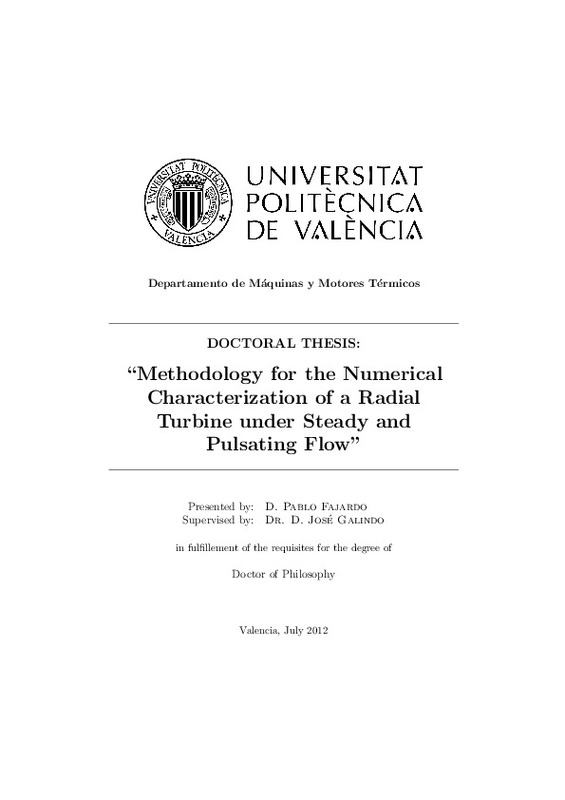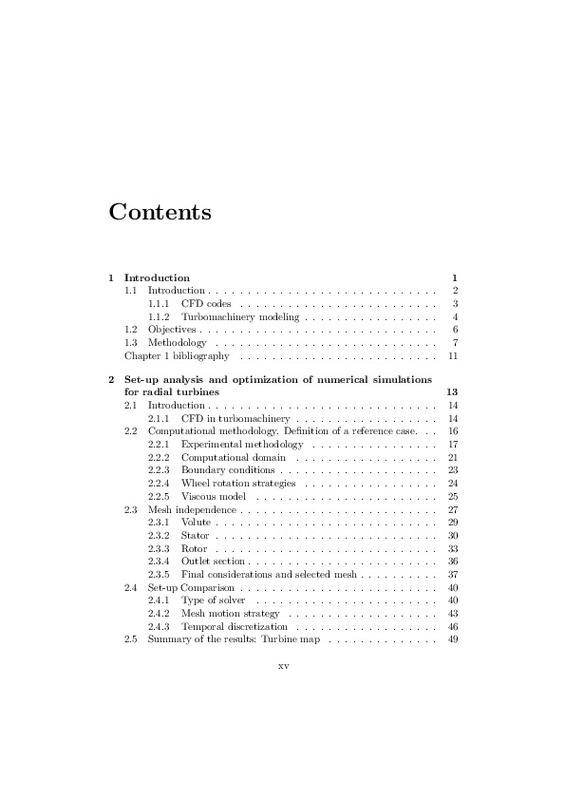- RiuNet repositorio UPV
- :
- Investigación
- :
- Tesis doctorales
- :
- Ver ítem
JavaScript is disabled for your browser. Some features of this site may not work without it.
Buscar en RiuNet
Listar
Mi cuenta
Estadísticas
Ayuda RiuNet
Admin. UPV
Methodology for the Numerical Characterization of a Radial Turbine under Steady and Pulsating Flow
Mostrar el registro sencillo del ítem
Ficheros en el ítem
| dc.contributor.advisor | Galindo Lucas, José
|
es_ES |
| dc.contributor.author | Fajardo Peña, Pablo
|
es_ES |
| dc.date.accessioned | 2012-07-26T06:42:13Z | |
| dc.date.available | 2012-07-26T06:42:13Z | |
| dc.date.created | 2012-07-20T08:00:00Z | es_ES |
| dc.date.issued | 2012-07-26T06:42:08Z | es_ES |
| dc.identifier.uri | http://hdl.handle.net/10251/16878 | |
| dc.description.abstract | The increasing use of turbochargers is leading to an outstanding research to understand the internal flow in turbomachines. In this frame, computational fluid dynamics (CFD) is one of the tools that can be applied to contribute to the analysis of the fluid-dynamic processes occurring in a turbine. The objective of this thesis is the development of a methodology for performing simulations of radial turbomachinery optimizing the available computational resources. This methodology is used for the characterization of a vaned-nozzle turbine under steady and pulsating flow conditions. An important effort has been devoted in adjusting the case configuration to maximize the accuracy achievable with a certain computational cost. Concerning the cell size, a local mesh independence analysis is proposed as a procedure to optimize the distribution of cells in the domain, thus allowing to use a finer mesh in the most suitable places. Particularly important in turbomachinery simulations is the influence of the approach for simulating rotor motion. In this thesis two models have been compared: multiple reference frame and sliding mesh. The differences obtained using both methods were found to be significant in off-design regions. Steady flow CFD results have been validated against global measurements taken on a gas-stand. The modeling of a turbine, installed either on a turbocharger test rig or an engine, requires the calculation of the flow in the ducts composing the system. Those ducts could be simulated assuming a one-dimensional (1D) approximation, and thus reducing the computational cost. In this frame of ideas, two CFD boundary conditions have been developed. The first one allows performing coupled 1D-3D simulations, communicating the flow variables from each domain through the boundary. The second boundary condition is based in a new formulation for a stand-alone anechoic end, which intends to represent the flow behavior of an infinite duct. Finally, the turbine was simulat | es_ES |
| dc.language | Inglés | es_ES |
| dc.publisher | Universitat Politècnica de València | es_ES |
| dc.rights | Reserva de todos los derechos | es_ES |
| dc.source | Riunet | es_ES |
| dc.subject | Turbocharging | es_ES |
| dc.subject | Computational fluid dynamics | es_ES |
| dc.subject | Mesh independence | es_ES |
| dc.subject | Radial turbine | es_ES |
| dc.subject | Pulsating flow | es_ES |
| dc.subject | Anechoic boundary condition | es_ES |
| dc.subject | 1d-3d coupling | es_ES |
| dc.subject | Turbine modelling | es_ES |
| dc.subject.classification | MAQUINAS Y MOTORES TERMICOS | es_ES |
| dc.title | Methodology for the Numerical Characterization of a Radial Turbine under Steady and Pulsating Flow | |
| dc.type | Tesis doctoral | es_ES |
| dc.identifier.doi | 10.4995/Thesis/10251/16878 | es_ES |
| dc.rights.accessRights | Abierto | es_ES |
| dc.contributor.affiliation | Universitat Politècnica de València. Departamento de Máquinas y Motores Térmicos - Departament de Màquines i Motors Tèrmics | es_ES |
| dc.description.bibliographicCitation | Fajardo Peña, P. (2012). Methodology for the Numerical Characterization of a Radial Turbine under Steady and Pulsating Flow [Tesis doctoral]. Universitat Politècnica de València. https://doi.org/10.4995/Thesis/10251/16878 | es_ES |
| dc.description.accrualMethod | Palancia | es_ES |
| dc.type.version | info:eu-repo/semantics/acceptedVersion | es_ES |
| dc.relation.tesis | 3883 | es_ES |
Este ítem aparece en la(s) siguiente(s) colección(ones)
-
Tesis doctorales [5389]







![Text file [Text]](/themes/UPV/images/text.png)


